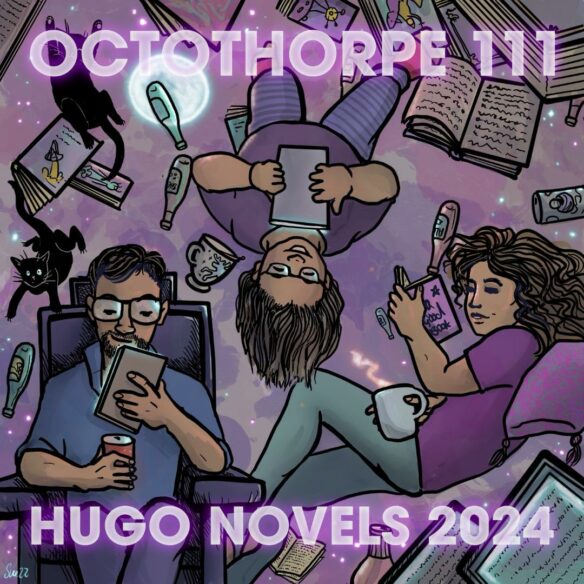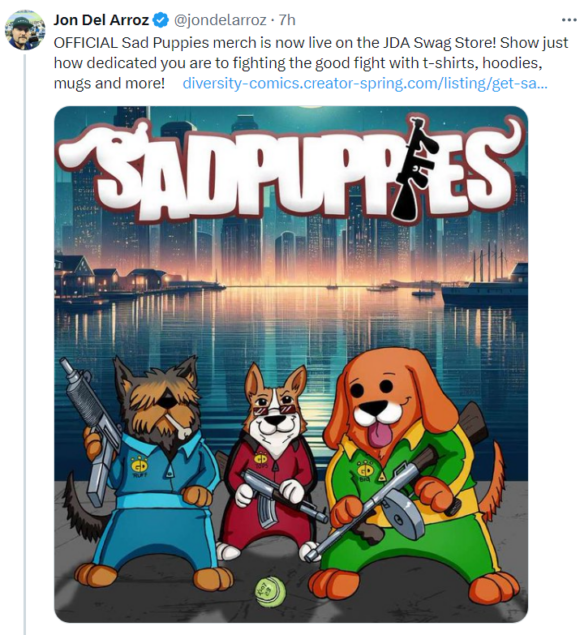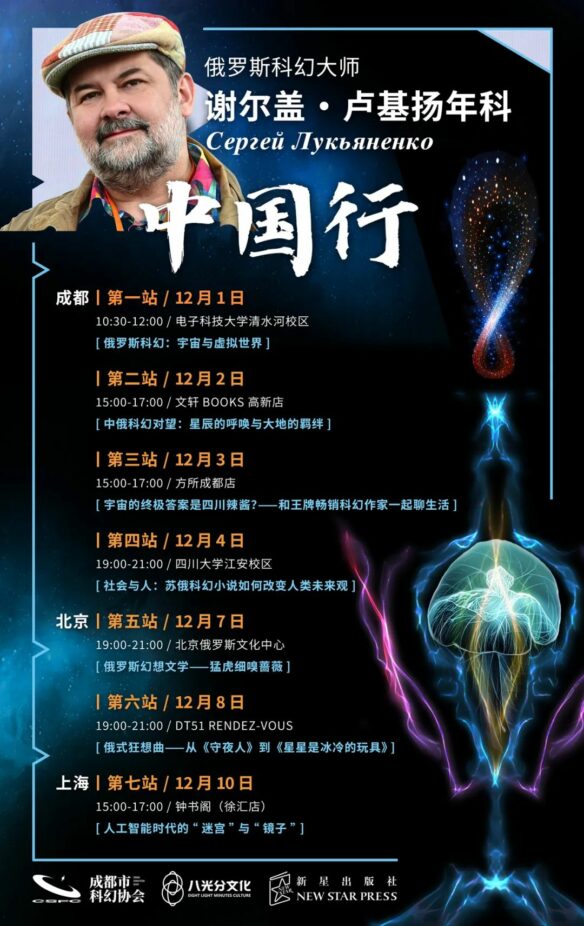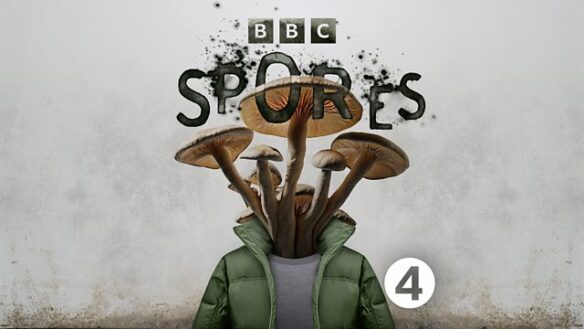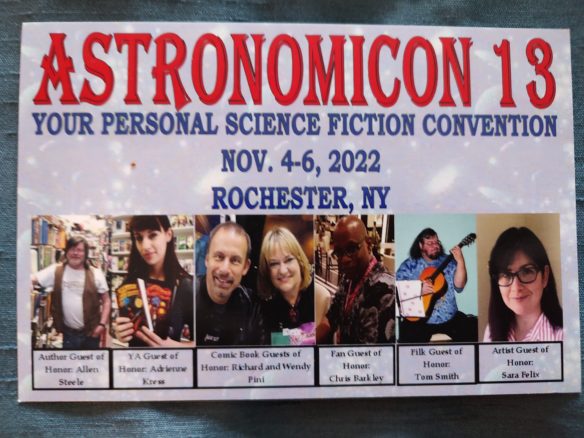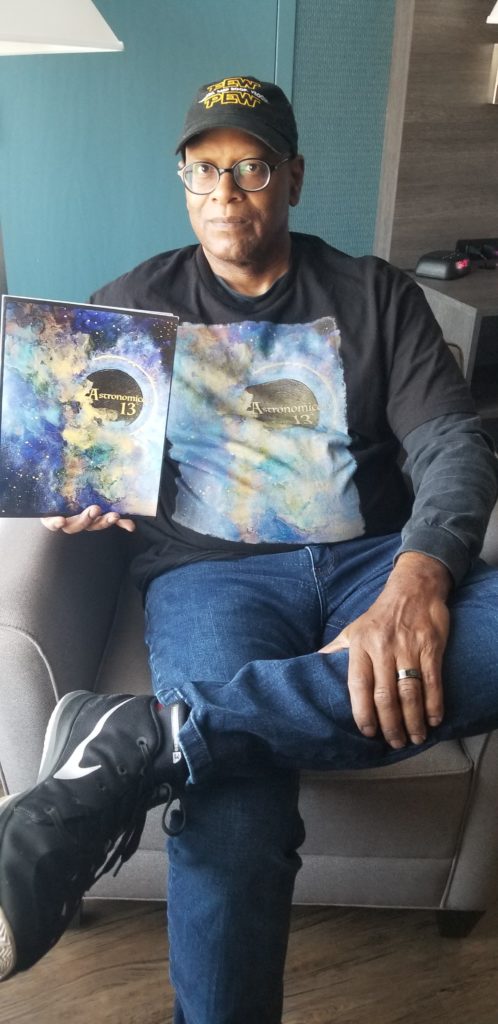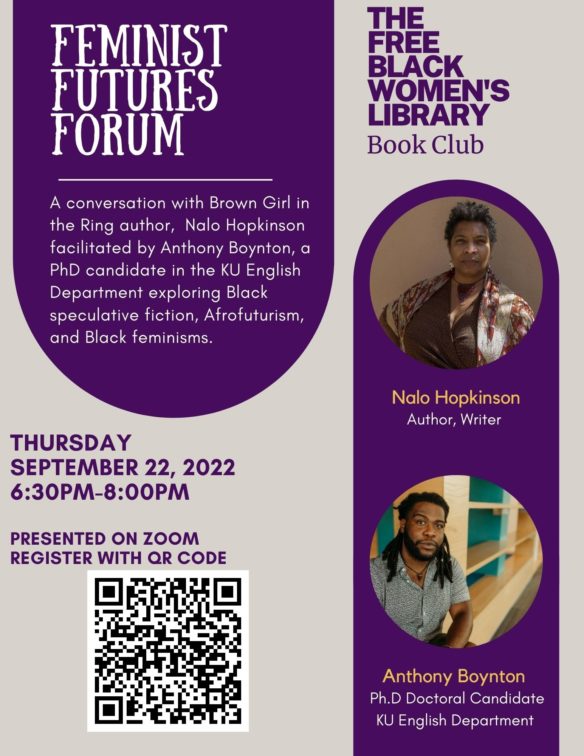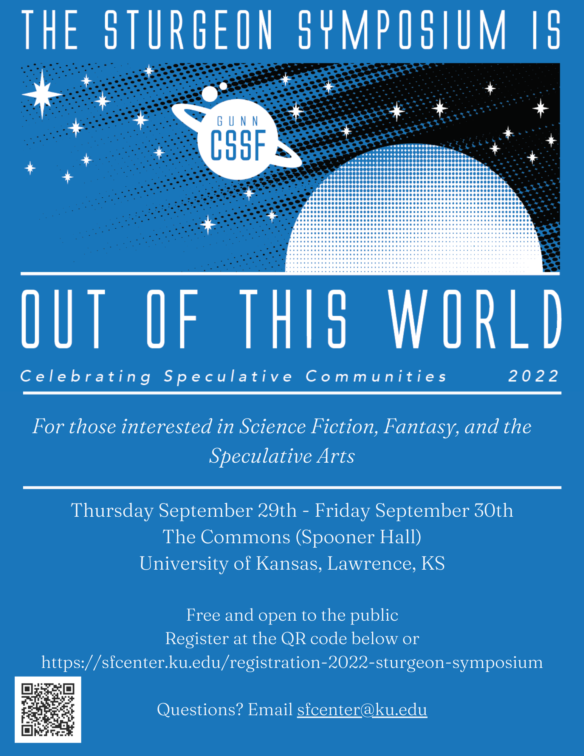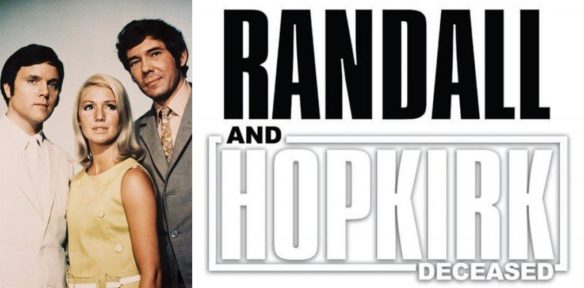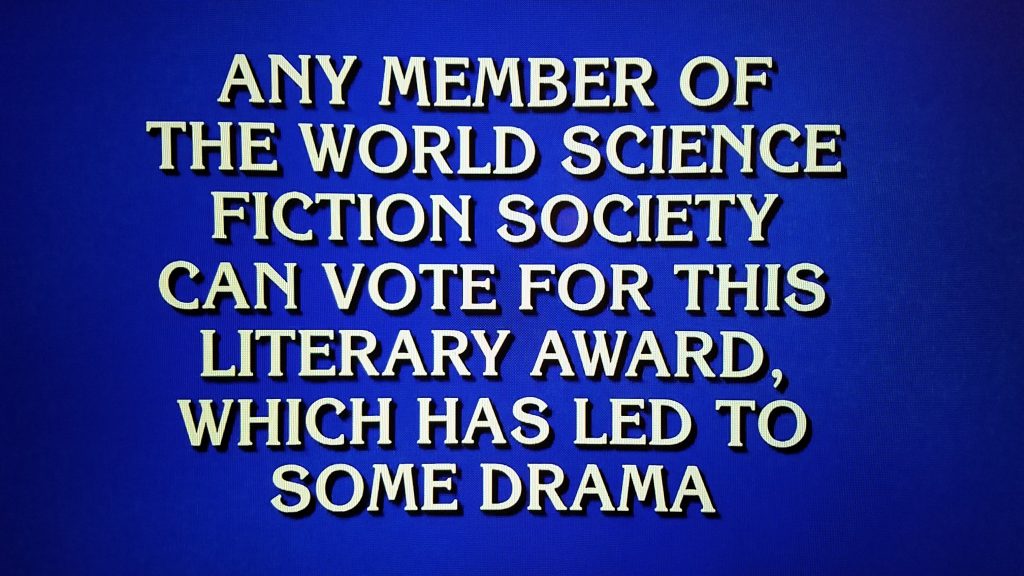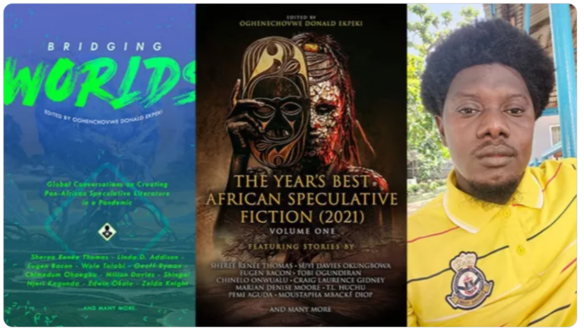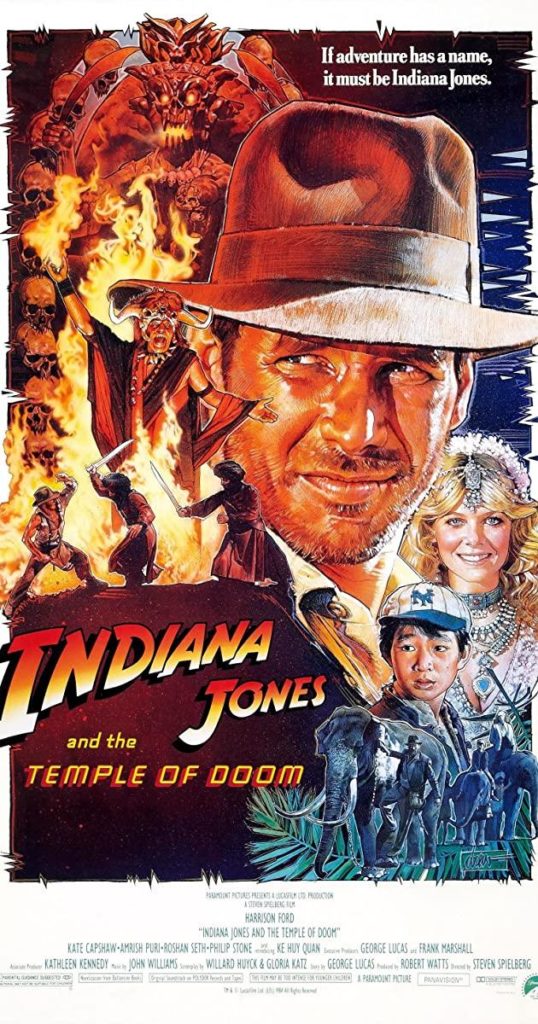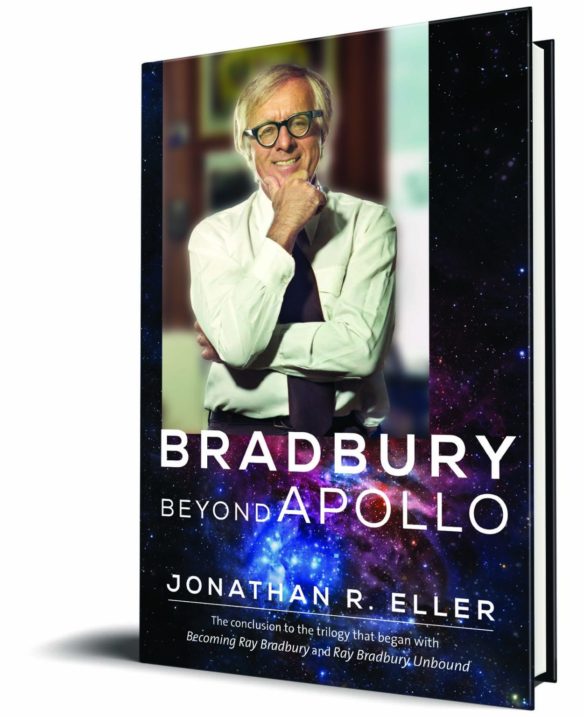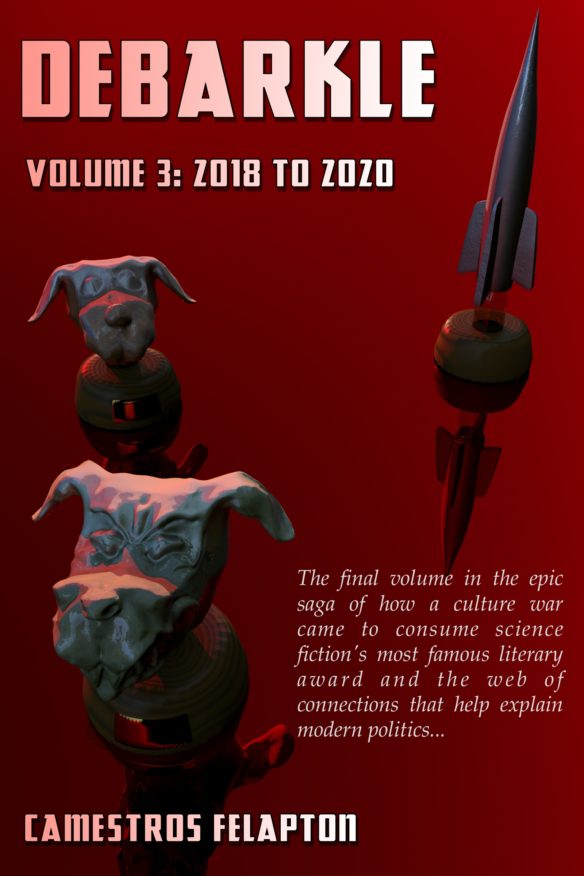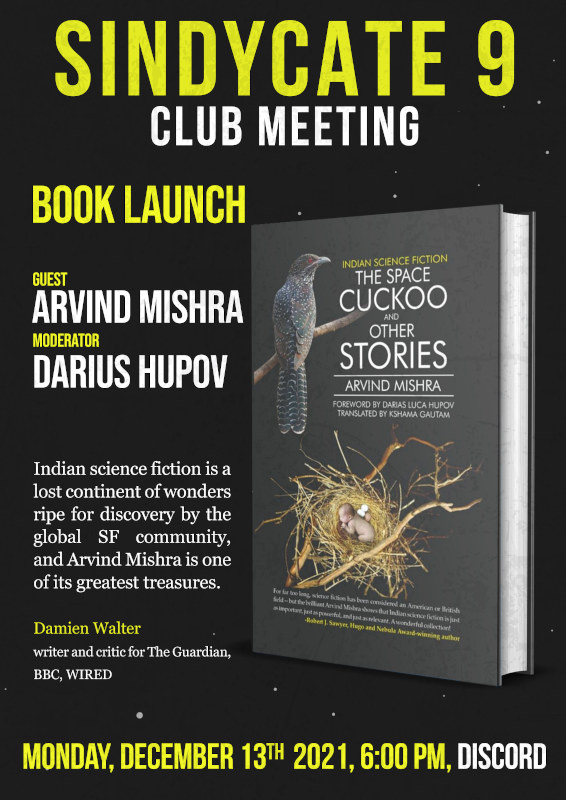(1) BEST OF NATURE FUTURES SF STORY NOW UP – OPEN ACCESS. [Item by SF Concatenation’s Jonathan Cowie.] SF² Concatenation has just posted its third ‘Best of’ Nature short SF stories of the year. These are normally behind a pay wall, but SF² Concatenation has permission from Nature and the respective authors to re-post.
The latest story is “The Nana Inheritance” by Amanda Helms.
The deathbed of your beloved grandmother isn’t really the place where you should decide who inherits her brain, but that’s what we did…
SF² Concatenation will have one more – the final of the year – short story mid-December to hold you over the festive season. Mid-January will see its spring (northern hemisphere academic year) edition with a huge news page, articles, conreps and a stack of book reviews…
(2) BOARD OF THE DINGS. Repeat after me, the British Board of Film Classification knows best. Now spit. “British film censors re-classify Return of the Jedi” reports Irish news outlet RTE.
Star Wars Episode VI: Return Of The Jedi has been reclassified from a U to a PG in the UK due to its violence and a scene which shows one of the film’s heroes Han Solo frozen in carbonite.
The British Board of Film Classification (BBFC) had given it a U rating upon release in 1983, but said “the detail and overall intensity” of violence in the film meant that it was changed to PG last year for violence and threat, despite this being “offset by humour and an emphasis on loyalty in adversity”.
A U rating means the film is suitable for audiences aged four and above and should be “family-friendly”, while a PG rated film contains some content that may not be suitable for children and parents or guardians are advised to be present while they are watching.
In its 2023 Annual Report, which saw the sci-fi film reclassified, the BBFC said of Star Wars Episode VI: “This sci-fi adventure sequel concerns rebel heroes who must rescue their friends before facing an intimidating enemy army.
“As well as laser gun fights, aerial dogfights, and fight scenes which include the occasional use of improvised weapons, a person falls to a presumed but unseen death, a villain tortures a character by repeated electrocution, and a hero severs a villain’s hand at the wrist in a scene featuring limited detail.
“A captor attempts to feed his prisoner to a monster, and there are other scenes of threat involving bombs, hostages and a hero being frozen alive.”…
… The BBFC said the sequences were “no longer within our standards at U” despite upholding the initial rating for video and theatrical releases in 1987 and 2008….
(3) YOU CAN CHECK IN ANY TIME YOU WANT. “Doctor Who’s Steven Moffat confirms Christmas special plot details – including ‘time-travelling hotel’” – Radio Times has them.
…Moffat has teased some further details about what’s to come in the new episode.
Speaking to BBC South East news, Moffat revealed: “I can tease something about the Christmas special. Imagine in the far, far future, imagine that a hotel chain got hold of the idea of time travel. What’s the first thing a hotel chain would do if they had time travel? They’d realise they had an opportunity to sell all the unsold nights in their own hotels in history.”…
(4) THE BOWERY’S UP AND HOGWARTS IS DOWN. “Two New York City bakers to compete on new Food Network show ‘Harry Potter: Wizards of Baking’” – a New York Times story (behind a paywall).
A new competition baking show on Food Network is bringing the magic of Harry Potter to a grand scale.
“Harry Potter: Wizards of Baking” is a larger-than-life new baking show that fully immerses contestants in the Harry Potter universe. Hosted by James and Oliver Phelps (who play Fred and George Weasley in the movie franchise), the show blends legendary storytelling and fantastical edible creations all on the competition floor.
“It’s a baking competition, it starts off with 9 teams of two bakers who didn’t know each other before they got into the competition. These guys are professionals in what they do. They’re the best of the best in America,” said Oliver Phelps. “They’re going for the trophy of the Wizards of Baking Champions and each bake is based on a set from the actual studios in London, and they have to come up with some inspiration from that.”
“Wizards of Baking” pairs the competitors into teams of two and has them compete alongside each other throughout the duration of the competition. Each week, the bakers make grand, eye-catching creations based on different Harry Potter sets.
The show was shot at Warner Bros. Studios Leavesden in Watford, England, and to raise the stakes, contestants are given access to the actual film sets, including The Great Hall at Hogwarts School of Witchcraft and Wizardry, Platform 9¾, Gringotts Wizarding Bank and The Burrow. The winners will be awarded the first-ever Wizards of Baking Cup and will have the opportunity to appear in a new Harry Potter cookbook….
(5) SAD, RABID PUPPY STUDIES. Jess Maginity reviews Speculative Whiteness: Science Fiction and the Alt-Right by Jordan S. Carroll for the LA Review of Books in “Whose Future Is It Anyway?”
…In his introduction, Carroll discusses the close proximity of science fiction to radical right-wing politics since the early 20th century. To some extent, popular culture was always a tool used by the Far Right. Theorists of the French New Right described intentional ideological influence on popular culture aimed at a distant political victory as “metapolitics.” As Andrew Breitbart summarizes, “Politics is downstream from culture.” Carroll describes this tactic, alluding to his focus on speculative genres, as “fascist worldmaking.” The ideology that structures fascist worldmaking is speculative whiteness: “For the alt-right,” Carroll says, “whiteness represents a matrix of possibilities more important than any actual accomplishments the white race may have already achieved.” There are five “myths” that constitute speculative whiteness: first, white people are uniquely good at speculating about the future and innovating in the present; second, nonwhite people are incapable of imagining the future and making long-term plans for the future; third, the true grandeur of whiteness will only be apparent in a high-tech fascist utopia; fourth, science fiction is a genre only white authors are truly able to produce; and fifth, speculative genres have the metapolitical potential of allowing a brainwashed white population to see their racial potential….
…Genres have no essential existence; people decide what they are. A categorical definition only makes sense when enough people agree with it. The science fiction community rejected the alt-right’s definition of speculative fiction. N. K. Jemisin, a primary target of reactionary fan hatred, won three consecutive Hugos for Best Novel with her Broken Earth trilogy. Chuck Tingle, who writes absurdist queer erotica, was mockingly nominated by the Rabid Puppies for several awards; he disavowed the nomination, tirelessly satirized the Puppies, and wrote Slammed in the Butt by My Hugo Award Nomination (2016) in response. He has since written two very successful queer horror novels, Camp Damascus (2023) and Bury Your Gays (2024). The Sad and Rabid Puppies dissolved after a few years of campaigning; they were primarily active from 2014 through 2016. The alt-right has also collapsed. After the 2017 Charlottesville Unite the Right rally, the alt-right as a movement effectively ceased to exist. That doesn’t mean that they just disappeared—some were absorbed by older radical right movements, others were absorbed into the mainstream, and a few became mass murderers in the name of a white future.
Carroll reminds us that our future is contingent. Fascists have a vision for the future that excludes most of humanity, but fascists can be defeated. The future is for everyone—if we make it that way….
(6) WHEN NEW WORLDS WAS NEW. The Spectator’s “Book Club” has a 43-minute audio interview with “Michael Moorcock: celebrating 60 years of New Worlds”. Listen to it at the link.
My guest in this week’s Book Club podcast is the writer, musician and editor Michael Moorcock, whose editorship of New Worlds magazine is widely credited with ushering in a ‘new wave’ of science fiction and developing the careers of writers like J G Ballard, Iain Sinclair, Pamela Zoline, Thomas M Disch and M John Harrison. With the release of a special edition of New Worlds, honouring the 60th anniversary of his editorship, Mike tells me about how he set out to marry the best of literary fiction with the best of the pulp tradition, how he fought off obscenity charges over Norman Spinrad’s Bug Jack Barron, about his friendship with Ballard and his enmity with Kingsley Amis – and why he’s determined never to lose his vulgarity.
(7) CHRISTOPHER TOLKIEN CENTENARY. The Tolkien Society has released the schedule for its free online Christopher Tolkien Centenary Conference, being held November 23-24.
This November marks 100 years since the birth of Christopher Tolkien and the Society will be holding a two-day online event in honour of his life and legacy. You can register to attend the online Conference below.
“We seek to honour and remember Christopher. Although we know the enormity of the world that Tolkien created, we only know that thanks to Christopher’s work. He spent almost 50 years after his father’s death to bring Tolkien’s legacy to us all. His hard work and diligence has shined a light on the corners of Middle-earth that would otherwise be unknown to us. We all owe him a tremendous debt, and I hope this event goes some way in recognising Christopher’s legacy as much as his father’s.” — Shaun Gunner, Chair of the Tolkien Society
I don’t know about your house, but a lot of the participants are household names in mine — Christopher Gilson, Brian Sibley, Christopher Gilson, Carl F. Hostetter, Douglas A. Anderson, Ted Nasmith, John D. Rateliff, Christina Scull and Wayne G. Hammond, John Garth, Robin Anne Reid, Michael D. C. Drout, and Verlyn Flieger.
Where possible, talks from both days will be recorded and uploaded onto the Tolkien Society YouTube channel after the event. The event is free to attend. Register here: Christopher Tolkien Centenary Conference.
(8) CLARION WEST CROWDFUNDING CAMPAIGN. Through December 4, Clarion West’s Fall Fundraiser at Indiegogo is encouraging donations with perks like these:
Would you like to join an RPG session with award-winning science fiction writer Annalee Newitz? Experience a Seattle escape room with horror and dark fantasy writer Evan J. Peterson? Benefit from a consultation with Susan Palwick or Ben Rosenbaum?
And there are many more at the link.
Donations help cover programs and events, including all of the following:
- Instructors: All of our programs are taught by paid professionals in the field of speculative fiction. Clarion West pays our instructors an estimated $55,000 per year
- Sliding scale tuition and application fees, reduced rates, free classes, and access seats: classes and workshops, travel, and time away can be a barrier to attending our programs. To reduce some of these barriers, we are committed to providing scholarships covering full and partial tuition to our residential workshops; discounts to reduce the cost of online classes; free events and programs for our community; and free seats in online classes for PGM/BIPOC writers. Clarion West covers an estimated $25,000 in fees for these programs.
- Reader honorariums: Clarion West pays a dedicated group of application readers an average of $5,000 each year to help manage the application process.
- ASL interpreters and live captioners: Clarion West spends approximately $270 per event or $2,700 for live captioning services for live events and $350 for ASL interpreters for live events.
- Clarion West pays $4,200 annually for class and on-demand platforms
- Six-Week Workshop venues, such as university dorms range between $45,000-$90,000 for in-person years like 2024
(9) TIM SULLIVAN (1948-2024). Author and filmmaker Timothy Sullivan died November 10 of congestive heart failure in hospice in Newport News, Virginia.
His first published story, “Tachyon Rag”, appeared in Unearth in 1977. His short story “Zeke”, published in Twilight Zone, was a 1982 Nebula nominee.
Although mainly known as a writer and actor, his contribution to one of fanhistory’s most bitter fan feuds should not be forgotten. He and Somtow Sucharitkul split from the Washington Science Fiction Association during the exceptionally bitter Dunegate feud of the Eighties, nominally provoked by the way passes were distributed to a local publicity screening of David Lynch’s movie. They formed the Washington Alternative SF Association, and published the fanzine Dune Gate to prosecute the feud.
Later, Sullivan was cast by Somtow (along with other friends) in the film The Laughing Dead, a credit mentioned in The Hollywood Reporter’s tribute “Tim Sullivan Dead: Sci-Fi Author, Actor and Screenwriter Was 76”.
…He also wrote and directed Vampyre Femmes (1999) and appeared in such straight-to-video releases as The Laughing Dead (1989), Eyes of the Werewolf (1999), The Mark of Dracula (2000), Hollywood Mortuary (2000) and Deadly Scavengers (2001), working often with writer-director Ron Ford.
Sullivan wrote at least seven sci-fi novels during his career, three of them based on Kenneth Johnson’s V NBC miniseries and series in the mid-1980s about an alien invasion of Earth….
…He wrote dozens of short stories, including 1981’s “Zeke,” a tragedy about an extraterrestrial stranded on Earth that was nominated for a Nebula Award. His novels included 1988’s Destiny’s End, 1989’s The Parasite War, 1991’s The Martian Viking and The Dinosaur Trackers and 1992’s Lords of Creation….
…He also edited horror anthologies and handled book reviews for The Washington Post.
(10) TODAY’S BIRTHDAY.
[Written by Paul Weimer.]
November 14, 1961 — Cat Rambo, 63.
By Paul Weimer: First and foremost Cat Rambo is a beacon of teaching in the science fiction community. Her Rambo Academy for Wayward Writers classes are a wealth of information and education in how to write science fiction and fantasy that stand up as educational, fun and practically useful. (Disclaimer: I co-taught a class in the Academy on maps in fantasy novels with Alex Acks.). The best teacher is to practice and read others work, but if you want some formal instruction short of going to a Clarion or the like (or don’t feel ready for that yet), Cat’s courses may be the solution you are looking for. She has a swath of excellent guest teachers to give ballast to her courses.
Besides her pedagogical pursuits, I enjoy her fiction. There is a coziness to a lot of her fiction, particularly the You Sexy Thing and its sequels, which are my favorite of her work. It’s not that they are entire creampuffs of novels, but there is a sense of fun, playfulness and comforting adventure…plus food, and cooking and misadventures, that make the book page-turners for me. Rambo does do a really good job in what a lot of authors don’t get to do or don’t want to do–recapping a series so that I can better remember what was going on. In reading the latest of the series, over a year since I read The Devil’s Gun, the recap Rambo gave helped click the neurons and have a rush of remembrance about what I was plunging into with Rumor Has It.
Given that this is an open ended and every complexifying series, I appreciate this service for the reader. It makes the work of trying to remember things less taxing, and allows me as a reader to focus on the fun of the books, and how she is layering plot and character with each successive novel. Reading and talking with Cat as to how she handles character growth and development brings home to me that her teaching, her classes really are reflected in her own novels, and vice versa.

(11) COMICS SECTION.
- The Argyle Sweater demonstrates the risks of airplane mode.
- Wumo chooses the wrong room.
- Eek! illustrates stubbornness.
(12) THE OTHER HANNIBAL. Even if that’s the character who comes to mind when you see that name, he won’t be playing Hannibal Lecter. “Denzel Washington: ‘Black Panther 3’ Will Be One of His Last Movies” reports Variety.
Denzel Washington revealed in August that “there are very few films” left for him to make at this stage in his Oscar-winning career, but now he’s revealing that “Black Panther 3″ is one of them. Speaking to Australia’s “Today” while on the press tour for “Gladiator II,” Washington said that director Ryan Coogler is writing him a role in the third “Black Panther” film. It will be one of Washington’s final movies along with a new Steve McQueen project and a film adaptation of Shakespeare’s “Othello.”
“For me it’s about the filmmakers. Especially at this point in my career, I am only interested in working with the best,” Washington said. “I don’t know how many more films I’m going to make. It’s probably not that many. I want to do things I haven’t done.”
“I played Othello at 22. I am about to play Othello at 70,” he continued, referring to the Shakespeare production co-starring Jake Gyllenhaal that opens on Broadway in February 2025. “After that, I am playing [Carthaginian general] Hannibal. After that, I’ve been talking to Steve McQueen about a film. After that, Ryan Coogler is writing a part for me in the next ‘Black Panther.’ After that, I’m going to do the film ‘Othello,’ After that, I’m going to do King Lear. After that, I’m going to retire.”
(13) UNSAFE AT ANY SPEED. The New York Times article “Take the ‘Death Stairs’ if You Dare” is paywalled, but the Facebook group “Death Stairs” is public and has lots of bizarre photos.
…No guardrails? Check. Carpeting that makes you lose your footing? Check. Steps of inconsistent depth and width? Check.
The more peril in the surrounding space, the better.
Do the stairs end in a dark basement? Excellent. Is the steep cement staircase guarded by rusting barbed wire on one side and open to a rushing dam on the other? Ideal….
Lane Sutterby, who lives in Kansas, had modest ambitions when he created the Death Stairs group in November 2020.
“I figured I’d have 10, 15 people join, maybe some of my close friends and a couple of random strangers,” he said….
…Some contributions to the Death Stairs Facebook page show how steep, rickety stairs are not the only risk. Distracting visual cues, inadequate hand rails and hard-to-see step edges are common….

(14) HOW CAN I GET THIS CAR OUT OF SECOND GEAR? [Item by Steven French.] Forget the jet packs, where’s my nuclear powered car?! “Visions of Nuclear-Powered Cars Captivated Cold War America, but the Technology Never Really Worked” in Smithsonian Magazine. Archival photos at the link.
In theory, nuclear-powered cars could run for thousands of miles without refueling, and some could even fly. But several problems remained. For one, nobody had developed a nuclear power plant small enough to fit into a car. For another, scientists calculated that an automobile with enough lead and other materials to shield the driver and passengers from radiation would weigh at least 50 tons, making it more than 25 times as heavy as the average vehicle. There was also the question of what to do with the nuclear waste.
These issues were never resolved, and the world quickly moved on. Still, the surviving prototypes offer a tantalizing glimpse of what might have been.
For one example, the Studebaker Astral.
(15) ROCKET TO THE MORGUE? Could it be dead, Jim? Futurism says “It Sounds Like NASA’s Moon Rocket Might Be Getting Canceled”.
NASA’s plagued Space Launch System rocket, which is being developed to deliver the first astronauts to the Moon in over half a century, is on thin ice.
According to Ars Technica senior space reporter Eric Berger’s insider sources, there’s an “at least 50-50” chance that the rocket “will be canceled.”
“Not Block 1B. Not Block 2,” he added, referring to the variant that was used during NASA’s uncrewed Artemis I test flight in 2022 and a more powerful design with a much higher translunar injection payload capacity, respectively. “All of it.”
To be clear, as Berger himself points out, we’re still far “from anything being settled.” Nonetheless, the reporter’s sources have historically been highly reliable, suggesting the space agency may indeed be getting cold feet about continuing to pour billions of dollars into the non-reusable rocket.
The SLS has already seen its fair share of budget overruns and many years of delays. In a 2022 interview, former NASA deputy administrator Lori Garver told Futurism that the project is simply “not sustainable.”
The rocket platform has become a political football, going well past $6 billion over budget and over half a decade behind schedule….
(16) NOT THE VIDEO OF THE DAY. “Disgusting, isn’t it? John Lewis’s shocking Christmas advert is actually about … shopping” – the Guardian sounds mighty peeved. Hopefully, they’re kidding.
Well, this is an outrage. There are just some things you shouldn’t mess with. Roast dinners. The national anthem. The John Lewis Christmas advert.
You see, the John Lewis Christmas advert has long operated on a perfect formula. Every November we are treated to a sumptuous mini-movie, the components of which have long since lapsed into tradition. It must be festive. It must have a slowed down piano ballad cover version of a nostalgic pop song. It must also be unfathomably sad, either because it’s about an old man dying of loneliness on the moon (2015) or a Christmas tree being banished to the garden because it’s a bit too excitable (2023).
But most importantly – most importantly of all – it must not be about John Lewis. The whole point of a John Lewis Christmas advert is that, if people watch it out of context and are subsequently asked what it is advertising, they should ideally reply ‘palliative care’ or ‘some sort of childhood trauma charity’. The point of a John Lewis Christmas advert is that a foreigner should be able to watch it all the way through and still have no idea what John Lewis is or why his kink is making people from Surrey cry.
But forget that this year. Because this year, John Lewis has thrown all that in the bin. This year, John Lewis has committed the unforgivable sin of literally setting its Christmas advert inside an actual branch of John Lewis. This is quite frankly unforgivable….
I kind of like it….
[Thanks to John King Tarpinian, Chris Barkley, Cora Buhlert, Cat Eldridge, SF Concatenation’s Jonathan Cowie, Steven French, Kathy Sullivan, Teddy Harvia, Mike Kennedy, and Andrew Porter for some of these stories. Title credit belongs to File 770 contributing editor of the day Shao Ping.]


